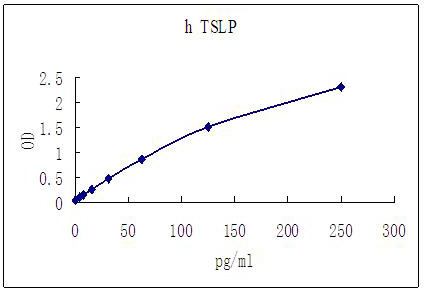Human TSLP ELISA Kit (96-well)
USD 475.00
3 Weeks*
Specifications
| Product Data | |
| Format | 96-well strip plate |
| Assay Type | Solid Phase Sandwich ELISA |
| Assay Length | 3 hours |
| Signal | Colorimetric |
| Curve Range | 3.9-250pg/ml |
| Sample Type | Cell culture supernatant, serum, plasma (EDTA, citrate, heparin) |
| Sample Volume | 20 uL |
| Specificity | Natural and recombinant Human TSLP Ligand |
| Sensitivity | 2pg/mL |
| Reactivities | Human |
| Interference | No significant interference observed with available related molecules. |
| Components |
|
| Background | Thymic Stromal Lymphopoietin (TSLP) is a 23 kDa member of the IL-7 family of a-helical cytokines . It is a monomeric glycoprotein that is synthesized as a 159 amino acid (aa) precursor . TSLP appears to have species-specific functions. In mouse, TSLP was initially reported to act on NK cells, mast cells, and B cells, but this does not appear to occur in humans. In humans, TSLP is produced by a number of divergent cell types, all of which appear to target T cells, monocytes, and/or dendritic cells . On TCR-activated T cells, TSLP directly induces T cell proliferation . The significance of this direct action is unclear. On monocytes, TSLP is reported to induce the release of multiple chemokines that target CCR4, a receptor associated with the Th2 subset . TSLP is best known for its direct action on subsets of dendritic cells. In thymic medulla, HassellÂ?s corpuscle epithelium produces TSLP that acts on resident CD11c+ dendritic cells. This induces the expression of B7 family molecules on dendritic cells, which subsequently convert regional CD4+CD25+ (potentially) autoreactive T cells into CD4+CD25+FOXP3+ regulatory T cells . Allergen-challenged keratinocytes are also known to produce TSLP in skin where TSLP acts on Langerhans cells (CD1a+ immature dendritic cells) which then migrate to regional lymph nodes and express B7-2/CD86, CD83, high levels of MHC-II, and TARC. TARC attracts naive CD4+ T cells to the TSLP-activated Langerhans cells, and this interaction induces a Th2 phenotype. TSLP-induced Th2 cells are strong producers of IL-13, IL-5, and TNF-a, all of which promote allergic-type inflammations . |
| Gene Symbol | TSLP |
| Gene ID | 85480 |
| Standard Curve |

Representative standard curve for TSLP ELISA. TSLP was diluted in serial two-fold steps in Sample Diluent.
|
Documents
| SDS |
{0} Product Review(s)
Be the first one to submit a review






























































































































































































































































 Germany
Germany
 Japan
Japan
 United Kingdom
United Kingdom
 China
China